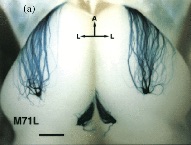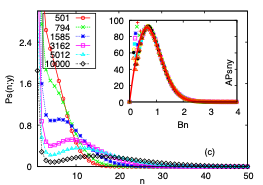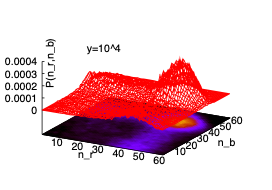fasciculation of olfactory axons

Neural growth and formation of bundle of neurons: Sensory neurons located in peripheral tissues grow their axons to definite parts in the brain where the signals are assimilated for further processing. Quite generically the growing axons interact with their environment, often provided by shafts of other axons, and they eventually die and get replaced by new axons. This turnover, for mammalian olfactory sensory neurons (OSN), interestingly, persists throughout the lifetime of an animal. The axons of olfactory sensory neurons expressing distinct odorant receptors are thought to have contact interactions which depend on the receptor. The growing axons form bundles and sort by types of receptors. The mature connectivity pattern is established only after several turnover periods.
periods.

We aim to answer an important question in current olfactory biology: is the convergence of axons into glomeruli achieved predominantly through guidance of individual axons by spatially distributed external cues, or is it the result of a collective process arising from axon-axon interactions? To this end, we study the collective effects, in neural bundling and sorting dynamics, that arise from direct contact interactions among axons with permanent turnover.
[Figure on the left: Image of Olfactory bulb of mouse  adapted from P. Feinstein and P. Mombaerts, Cell 117, 817 (2004) ]
adapted from P. Feinstein and P. Mombaerts, Cell 117, 817 (2004) ]

The growing axons are represented as interacting directed random walks in two spatial dimensions. To mimic axonal turnover, random walkers are injected and whole paths of individual walkers are removed at specified rates. We have characterized the dynamical steady state and the approach to it. The dynamical steady state is characterized by a position-dependent distribution of bundle sizes that obeys a scaling law. We identified several distinct time scales, which are sensitive functions of the microscopic parameters of the model, that emerge from the dynamics and can exceed the average axonal lifetime by orders of magnitude. Building up o n these findings, we explored the emergent dynamics of a system containing two types of axons, with type-specific interaction strengths. We introduced a bundle purity order parameter to identify the type-wise purity of a bundle. The emergence of bundle purity shows the same time scales as the average bundle size, however, the steady state bundle purity shows a non-monotonic spatial variation indicating a length scale at which one should expect the formation of purest bundles. For details, see Europhys. Lett. 87, 20003 (2009) and Phys. Rev. E 84, 021908 (2011).
n these findings, we explored the emergent dynamics of a system containing two types of axons, with type-specific interaction strengths. We introduced a bundle purity order parameter to identify the type-wise purity of a bundle. The emergence of bundle purity shows the same time scales as the average bundle size, however, the steady state bundle purity shows a non-monotonic spatial variation indicating a length scale at which one should expect the formation of purest bundles. For details, see Europhys. Lett. 87, 20003 (2009) and Phys. Rev. E 84, 021908 (2011).

Currently we are investigating how neural fasciculation impacts signal transduction in Olfactory neurons via ephaptic coupling.